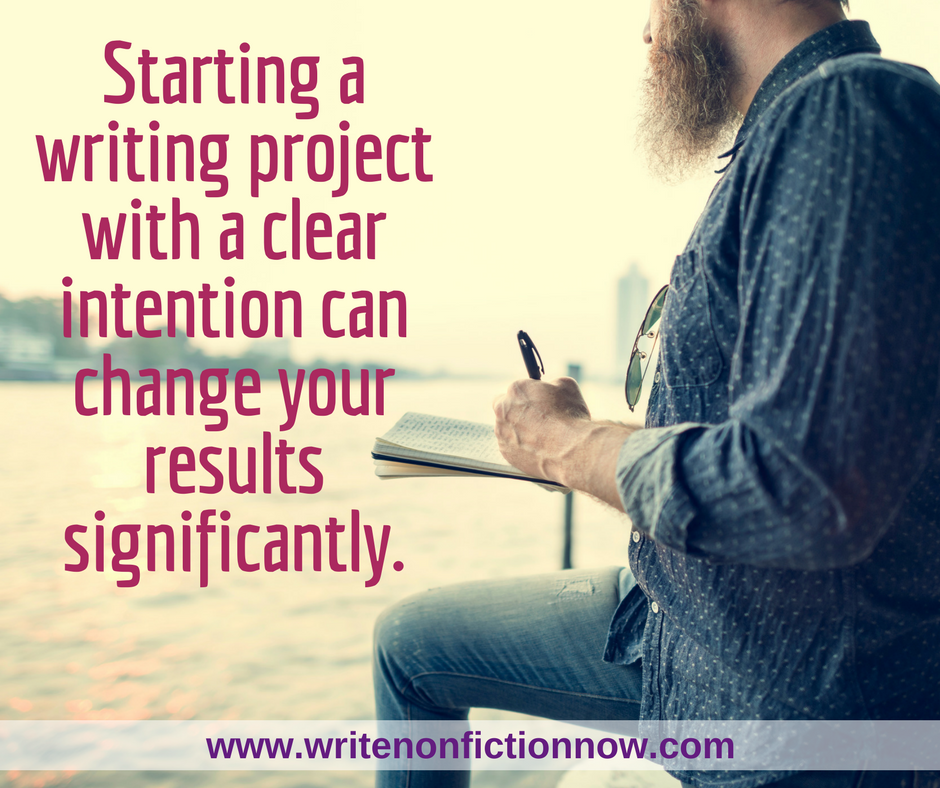Wednesday, April 11, 2018

Do you set writing intentions? And does it help you write better, faster, or more creatively? Today, professional writer Deb Hemley (
@dhemley) explores how sitting down to write with a clear intention changes your writing results.
Over the years, I’ve been a participant in several weeklong and weekend workshops and a member of an ongoing writers group for nearly ten years. Whether it’s the pressure of a deadline or being with others who want to live, breath and talk writing for a period, I’ve witnessed and experienced firsthand the myriad ways a good workshop can help a writer.
For as long as I can remember, I’ve been curious about why certain things may happen for a writer during a workshop experience. For example:
- Why can writers sometimes do their best work in the workshop setting?
- How is it that (seemingly innocuous) writing prompts and in-the-moment assignments can yield tremendous results (especially within a 15 to 30 minute timed exercise)?
- What makes the writer suddenly able to remember an event from years ago?
- How can a writer identify for the first time an everyday object that has significance for them?
- What contributes to a writer’s ability to write fast and furiously from the get-go?
During a recent yoga class I attended, the teacher read a few paragraphs from Donna Farhi’s book,
Bringing Yoga to Life. My ears perked up as she read, “In truth, it matters less what we do in practice than how we do it and why we do it. The same posture, the same sequence, the same meditation with a different intention takes on an entirely new meaning and will have entirely different outcomes.”
Intention. Really?
Farhi goes on to say, “Unless we know what our intention is, we have little means of consolidating all the components of our practice and bringing them into a unified action toward our goal.”
Making intentions about how and why we write can be critical to our process. Click To Tweet
Making Intentions
Making intentions about how and why we write can be critical to our process. When we decide, for example, to attend a writing workshop and set aside all distractions for a specified amount of time, knowingly or unknowingly we’ve made an intention.
In the book
Fearless Writing: How to Create Boldly and Write with Confidence, William Kenower writes that intention is one of three narrative arcs that are part of every story:
- physical
- emotional
- intentional
In short:
- The physical arc is the one people want you to describe when they ask what your story is about or for details about the characters and the time and place of your story.
- The emotional arc is the character’s motivations—what they feel and how they respond to those feelings.
- The intentional arc explains the reasons why you told the story, the guiding thought behind the choices you made as a storyteller, and the point of view from which your portrait of life is drawn. Kenower suggests that the intentional arc is the most important of all!
Unearthing the Seeds of Our Ideas
According to Kenower, most writers don’t begin a story knowing its intentional arc. Rather, they begin with a character, memory, or setting. The writer is interested in the seed of an idea for reasons they can’t fully name. Our job as writers is not to discover some brand-new intentional arc but to find the one that is most meaningful to us and tell it in our unique voice.
For instance, a few years ago I wrote an essay about a time during my childhood when I spent Sunday mornings at a bowling alley with my dad. I’d been thinking about writing the piece for a long time. I kept returning to memories of my dad’s bowling teammates, their uniforms, the smell of sweat, stinky shoes, and cigarettes as you walked through the door of the building. At first, I thought the piece was about simpler times, homage to the bowling alleys of yesteryear, and, in this particular situation, how crushed everyone in the community was years later when the building burned to the ground.
But it wasn’t until I reached the last line of the piece that I realized the seed for the story all along was: how much I missed my dad, who’d died nearly 20 years earlier. That realization was an
aha moment that literally and figuratively sent shivers down my spine. While I was writing the piece, I felt as if I’d been hanging out with my dad the whole time, that he’d been perched on my shoulder, gently encouraging me.
Keep going, Deb. You’ll get to the big reveal any moment now. When It’s All Said and Done
Most writers don’t begin a story knowing its intentional arc.
Click To Tweet
Discovering the meaning of the seeds for our stories may be one of the greatest gifts that writers and readers experience.Pay attention to every seed that comes your way whether you’re at a workshop or home alone staring at a blank screen (note: especially then). Unearth them and discover their meaning.This is the kind of adventure writers long for. I believe it does and will happen when we give ourselves the time and space—to set and fulfill—powerful intentions.
Do you set writing intentions? Tell me in a comment below. About the Author
 Deb Hemley
Deb Hemley writes memoir, personal essay, short fiction, and articles about social media. She has published pieces in
Biographile, Hippocampus Magazine, All That Matters, and
Survivor’s Review. You can follow her on Twitter
@dhemley.
Photo courtesy of Oleksii Zabusik|123RF.com The post
The Power of Setting Writing Intentions appeared first on
Write Nonfiction NOW!.
Nina Amir, the bestselling author of How to Blog a Book and The Author Training Manual, is a speaker, a blogger, and an author, book, blog-to-book, and high-performance coach. Known as the Inspiration to Creation Coach, she helps creative people combine their passion and purpose so they move from idea to inspired action and positively and meaningfully impact the world as writers, bloggers, authorpreneurs, and blogpreneurs. Some of Nina’s clients have sold 300,000+ copies of their books, landed deals with major publishing houses and created thriving businesses around their books. She is the founder of National Nonfiction Writing Month, National Book Blogging Month, and the Nonfiction Writers’ University. As a hybrid author she has published 19 books and had as many as four books on the Amazon Top 100 list at the same time. Her most recent book is called Creative Visualization for Writers, and tomorrow her 19th book will be released, The Write Nonfiction NOW! Guide to Creativity and Flow. Find all her books at booksbyninaamir.com or find out more about her at ninaamir.com.